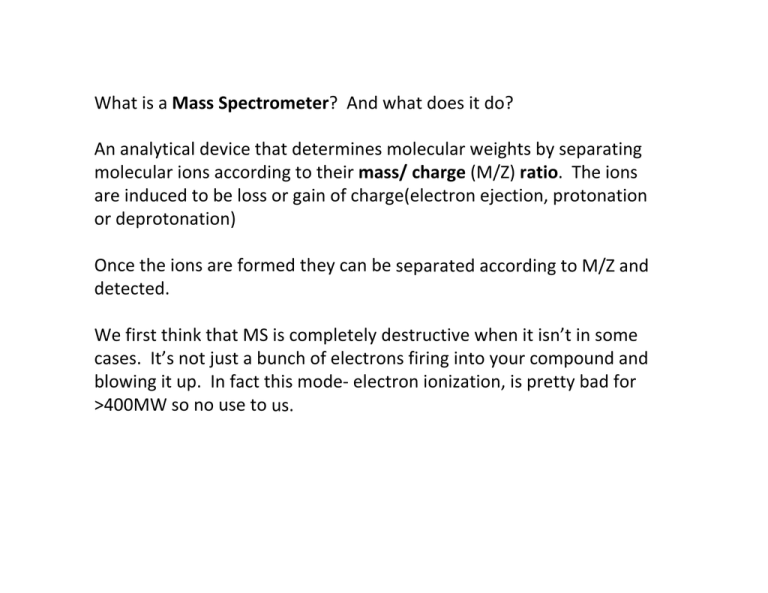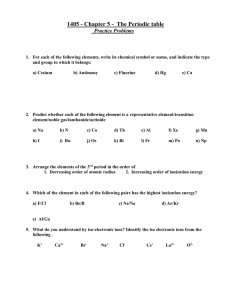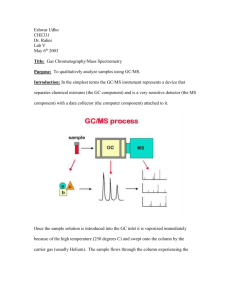What is a Mass Spectrometer? And what does it do? - Cavanagh-lab
advertisement

What is a Mass Spectrometer? And what does it do? An analytical device that determines molecular weights by separating molecular ions according to their mass/ charge (M/Z) ratio. The ions are induced to be loss or gain of charge(electron ejection, protonation or deprotonation) Once the ions are formed they can be separated according to M/Z and detected. We first think that MS is completely destructive when it isn’t in some cases. It’s not just a bunch of electrons firing into your compound and blowing it up. In fact this mode‐ electron ionization, is pretty bad for >400MW so no use to us. Ionization techniques Electron Ionization (EI) – beam/electron transfer Pushes charges molecules into e‐ beam The positive ion formation/electron ejection process in EI involves the following steps: 1.Electrons ejected from a heated filament are accelerated through an electric field at 70V to form an electron beam. 2.The sample is thermally desorbed into this electron beam 3.The electrons (having kinetic energy of 70 eV) transfer some of their kinetic energy to the molecule M. This transfer results in ionization (electron ejection) with usually no more than 6 eV excess energy. M + e‐ (70eV) Æ M+ (~5eV) + 2 e‐ (~65 eV) 4.Excess energy (6eV) in the molecule leads to some degree of fragmentation. M+ Æ entire molecular ion + fragment ions + neutral fragments If too much energy put inÆ complete destruction of fragment or BLOW UP! c v c v c v Fast atom bombardment Dissolve sample in matrix FAB matrix‐ a nonvolatile liquid material that serves to constantly replenish the surface with new samples as the incident ion beam bombards the surface. It also serves to minimize sample damage from the high‐energy particle beam by absorbing most of the incident energy and the matrix is believed to facilitate the ionization process. MALDI‐ matrix assisted laser desorption/ionization Permits the analysis of high molecular weight compounds Sample is dissolved in the matrix. The matrix absorbs the laser light energy causing the matrix material to vaporize. Once in the gas phase, the matrix may play a role in the ionization of the analyte molecules. Uncharged molecules will often react with the matrix or other molecules to produce charged species. MALDI matrix‐ nonvolatile solid material that absorbs the laser radiation resulting in the vaporization of the matrix and sample embedded in the matrix. It also serves to minimize sample damage from the laser radiation by absorbed incident energy. It also facilitates ionization process. Now close to 700,000 Electrospray Ionization ESI is a method used to produce gaseous ionized molecules from a liquid solution. Create a fine spray of highly charged droplets in the presence of a strong electric field. The sample solution is sprayed from a region of a strong electric field at the tip of a metal nozzle maintained at approx. 4000 V. The highly charged droplets are electrostatically attracted to the mass spec inlet. Either dry gas, heat, or other are applied to the droplets before they enter the vacuum of the mass spec, thus causing the solvent to evaporate from the surface. As the droplet decreases in size, the electric field density on its surface increases. The mutual repulsion between like charges on this surface becomes so great that is exceeds the forces of surface tension, and ions begin to leave the droplet through what is known as a Taylor cone. The ions are directed into an orfice though electrostatic lenses leading to the mass analyzer. ESI is conducive to the formation of the multiple charged molecules. The charge distribution profile has multiple peaks appear due to multiple charges on protein but one mass. To get the MW multiply the peak number and charge. Charge distribution profile gives information about conformational changes. A cluster of peaks to left means there is more charges on surface, more hydrophilic, and easy to put on a proton. A cluster of peaks to the right means the is less charges on surface, less hydrophobic, and harder to put on protons. Up to 100,000 Da Mass analyzers and Ion detectors Mass analyzers scan or select ions over a particular M/Z range (NOT mass) Quadrupole analyzer‐ four precisely parallel rods with a direct current voltage and a superimposed radio‐frequency potential. The A rods are connected and are at same DC and superimposed RF voltages. The same is true of the B rods but in the opposite DC voltage with respect to the A rods, and the RF field is phase shifted by 180o. The field on the quadropoles determines which ions are allowed to reach the detector. The quadrupoles this function as a mass filter which select 1 ion from another. As the field is imposed, ions moving into the field region will oscillate depending on the M/Z and RF. Only ions of a particular M/Z cam pass through the filter. If you scan the RF field then you can generate a mass spectrum. A series of mass filter spectra . Quadrupoles are tolerant of high pressure (ex atmospheric) and can easily analyze M/Z of up to 3000. This is all great for combining with ESI to produce a carge distribution below 3000M/Z. They are very CHEAP! Time of Flight Analyzer (TOF) A TOF analyzer is tremendously simple. It’s used a lot with MALDI. TOF is based on accelerating a set of ions to a detector with the same amount of energy. Because the ions have the same kinetic energy they will travel at different speeds to the detector since KE = ½ mv2 TOF: the smaller ion clearly move faster and arrive at the detector first The resolving power is OK, not great, but there seems to be no upper mass limit MALDI and ESI has soft ionization techniques and you don’t get fragment ions, just the molecular ion. SO you can size things but not analyze their composition—MS/ MS Tandem Mass Spectrometry ESI, MALDI– approx. NO fragment ions (unlike EI) MSn –collisionally generate fragments from a particular ion then MS those ‐put fragments in trap and add argon gas to help pick 1 ion @ a time to analyze You can imagine that using quadrupoles as a genuine mass filter is a great idea… Fragmentation can be achieved by inducing ion‐molecule collisions by a process known as collision‐induced dissociation (CID) or collision‐ activated dissociation. CID is accomplished by selecting an ion of interest with a mass filter/ analyzer and introducing that ion into a collision cell. A collision gas ( typically Ar) in introduced into the collision cell, where the selected ion collides with the argon atoms, resulting in fragmentation. The fragments can then be analyzed to obtain a daughter ion spectrum. Tandem mass analysis is primarily used to obtain structural information. MS/MS with a Triple quadrupole Mass Spectrometer Tandem mass spectrometry utilizes the second quadrupoles as a collision cell to generate fragment ions. The process of collision‐induced dissociation is initiated by selecting an ion having a particular m/z with the first quadrupole. Subsequently, only the selected ion is allowed to move into the second quadrupole where it collides with argon atoms and fragments. Theses fragments can then be analyzed with the 3rd quadrupole and structural info can be obtained. This technique is used extensively in peptide and carbohydrate sequencing. MALDI is useful for protein and peptide analysis. Great for complex mixtures ex. Edman degradation Can have salt present For proteins it s little less sensitive but still very good ESI Like MALDI, it adds protons to form ions No matrices, generates a spray of ions (multi‐charges) Multiple charging makes it possible to observe large proteins with mass analyzers that have a relatively small mass range Ex. 18000MW 3 charges 6000 Can average 9 charges very accurate MW’s 2000 etc. Remember the ionization process? The ions get formed then there are some collisions that can decluster aggregates, induce fragmentation and change charge states. Lowering the potential between the orifice and the quadrupole analyzer affects the energy of collisions prior to mass analysis—electrospray becomes more conducive to the observation of non‐covalent interactions. Sequencing



